Exercise enthusiasts and athletes are constantly seeking ways to enhance their performance and reduce fatigue. A groundbreaking study has revealed a promising new treatment that could revolutionize how we approach workouts. This article explores the potential of hydrogen-rich gas (HRG) inhalation as a pre-exercise strategy to combat fatigue and boost performance.
The Science Behind Hydrogen-Rich Gas
Hydrogen-rich gas is exactly what it sounds like - a gas mixture with a high concentration of hydrogen molecules. While hydrogen is the most abundant element in the universe, its potential benefits for human health and performance are only now being fully explored.
How Hydrogen Works in the Body
Hydrogen is a powerful antioxidant that can easily penetrate cell membranes and enter the mitochondria, the powerhouses of our cells. Once inside, hydrogen molecules can neutralize harmful free radicals, reducing oxidative stress and inflammation. This property makes hydrogen particularly interesting for exercise science, as intense physical activity often leads to increased oxidative stress in the body.
The Groundbreaking Study
A recent study published in the International Journal of Sports Medicine has shed light on the potential benefits of HRG inhalation before exercise. This research, conducted by an international team including scientists from the U.S., China, and the Hinda and Arthur Marcus Institute for Aging Research at Hebrew SeniorLife, provides compelling evidence for the use of HRG in exercise performance[2].
Study Design and Methodology
The study involved 24 healthy adult men who underwent rigorous testing to determine their maximum cycling power (Wmax) and maximum cycling time (Tmax). Using a double-blind, counterbalanced, randomized, and crossover design, participants inhaled either HRG or a placebo gas (air) for 60 minutes before cycling at 80% of their Wmax until exhaustion[2].
This robust study design ensures that the results are reliable and minimizes potential biases, providing a solid foundation for the findings.
Key Findings
The results of the study were remarkable, demonstrating several significant benefits of HRG inhalation:
- Reduced Perceived Fatigue: Participants who inhaled HRG reported significantly lower scores on the Visual Analog Scale (VAS) for fatigue compared to those who inhaled the placebo gas[2]. This suggests that HRG could help athletes and fitness enthusiasts push through intense workouts with less perceived effort.
- Improved Exercise Performance: HRG inhalation led to improved cycling frequency during the final 30 seconds of the exercise. Additionally, it reduced the rating of perceived exertion (RPE) at both the beginning and end of the ride[2]. This indicates that HRG not only helps at the end of a workout when fatigue typically sets in but also from the very start of exercise.
- Positive Impact on Oxidative Stress Markers: The study found that HRG inhalation significantly improved the body's ability to inhibit hydroxyl radicals and lowered serum lactate levels after exercise[2]. These findings suggest that HRG helps combat oxidative stress, which is a major contributor to exercise-induced fatigue.
- Functional Performance: While the study didn't find significant impacts on counter-movement jump (CMJ) height or glutathione peroxidase activity, the overall benefits on fatigue and oxidative stress markers were notable[2].
Implications for Athletes and Fitness Enthusiasts
The findings of this study have far-reaching implications for anyone engaged in regular physical activity, from professional athletes to weekend warriors.
Enhanced Training Efficiency
By reducing perceived fatigue and improving performance, HRG inhalation could allow athletes to train more effectively. This could lead to more productive workouts, potentially accelerating skill development and physical adaptations.
Improved Recovery
The reduction in oxidative stress markers suggests that HRG might also play a role in post-exercise recovery. By mitigating some of the cellular damage associated with intense exercise, HRG could potentially speed up recovery times and reduce the risk of overtraining.
Potential for Endurance Athletes
While the study focused on short-term, high-intensity exercise, the findings hint at potential benefits for endurance athletes as well. The ability to maintain a higher cycling frequency in the final stages of exercise could translate to improved performance in long-distance events.
The Mechanism of Action
To fully appreciate the potential of HRG, it's important to understand how it works within the body during exercise.
Antioxidant Properties
Hydrogen acts as a selective antioxidant, primarily targeting the most harmful free radicals, such as hydroxyl radicals. During intense exercise, the body produces an excess of these free radicals, which can damage cells and contribute to fatigue. By neutralizing these molecules, hydrogen helps maintain cellular health and function.
Mitochondrial Function
Some research suggests that hydrogen may also enhance mitochondrial function. Given that mitochondria are crucial for energy production during exercise, this could explain the improved performance observed in the study.
Lactate Metabolism
The lower serum lactate levels observed in the study participants who inhaled HRG are particularly interesting. While lactate itself isn't directly responsible for muscle fatigue, it's often used as a marker of high-intensity exercise. The reduction in lactate levels could indicate improved metabolic efficiency during exercise.
Potential Applications Beyond Sports
While the study focused on exercise performance, the benefits of HRG inhalation could extend to other areas of health and wellness.
Aging and Sarcopenia
As we age, our muscles naturally lose strength and mass, a condition known as sarcopenia. The anti-fatigue and performance-enhancing effects of HRG could potentially help older adults maintain muscle function and independence for longer.
Rehabilitation
For individuals undergoing physical rehabilitation after injury or illness, HRG inhalation might provide a way to enhance the effectiveness of their exercises, potentially speeding up recovery times.
Chronic Fatigue Conditions
While more research is needed, the fatigue-reducing properties of HRG could potentially benefit individuals with chronic fatigue syndrome or other conditions characterized by persistent fatigue.
Safety Considerations
As with any new treatment, safety is a paramount concern. The study reported no adverse effects from HRG inhalation, which is encouraging. However, it's important to note that this was a short-term study with healthy adult males. More research is needed to establish the long-term safety profile and potential effects on diverse populations, including women, older adults, and individuals with various health conditions.
Future Research Directions
While this study provides exciting initial results, it also opens up numerous avenues for future research:
- Long-term Effects: Studies examining the effects of regular HRG inhalation over extended periods are needed to understand any potential long-term benefits or risks.
- Different Exercise Modalities: Research on how HRG affects performance in various types of exercise, from strength training to endurance events, would provide a more comprehensive understanding of its potential applications.
- Dosage and Timing: Optimizing the concentration of hydrogen in the gas mixture and the timing of inhalation could potentially enhance the benefits.
- Combination with Other Strategies: Investigating how HRG inhalation interacts with other performance-enhancing strategies, such as nutrition or specific training protocols, could yield interesting results.
- Mechanism of Action: While we have some understanding of how hydrogen works in the body, more detailed research into its exact mechanisms during exercise could provide valuable insights.
Practical Considerations
For those excited by the potential of HRG, it's important to note that this is still an emerging field of research. HRG is not yet widely available for personal use, and any application should be under the guidance of trained professionals.
Availability and Administration
Currently, HRG is primarily used in research settings. As more studies confirm its benefits and safety, we may see the development of commercial products for athletes and fitness enthusiasts. However, it's crucial to wait for proper regulation and guidelines before considering personal use.
Integration with Existing Training Programs
If HRG becomes widely available, athletes and coaches will need to consider how to best integrate it into existing training programs. It may be particularly useful during high-intensity training sessions or in the lead-up to important competitions.
Conclusion
The discovery of hydrogen-rich gas as a potential treatment for exercise-induced fatigue marks an exciting development in sports science and exercise physiology. By reducing perceived fatigue, enhancing performance, and mitigating oxidative stress, HRG inhalation could become a valuable tool for athletes, fitness enthusiasts, and potentially individuals dealing with various health conditions.
However, it's important to approach these findings with cautious optimism. While the results are promising, more research is needed to fully understand the long-term effects, optimal usage, and potential applications of HRG inhalation. As we await further studies, this discovery serves as a reminder of the constant innovations in health and fitness science, always pushing the boundaries of human performance.
As we continue to explore the potential of hydrogen-rich gas, we may be on the cusp of a new era in exercise science - one where the air we breathe before a workout could be the key to unlocking our full physical potential.
Citations:













Member discussion